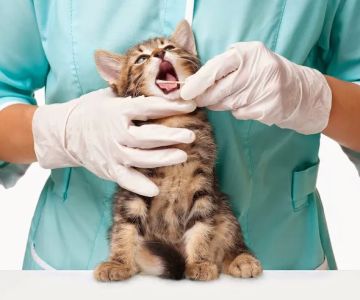Understanding Why Cats Bite
As a cat owner, one of the most frustrating behaviors to deal with is biting. Whether it's playful nips or more aggressive bites, it’s essential to understand the reasons behind this behavior before trying to fix it. For my cat, it started as a playful gesture when she was a kitten, but soon it became more frequent and painful. After researching and speaking with professionals, I realized that biting is often a form of communication for cats. They may bite due to fear, overstimulation, or simply to express excitement.

1225 Warren Ave, Downers Grove, IL 60515, USA
See DetailsSetting Boundaries Early: The Importance of Early Training
Training your cat from an early age is crucial in preventing biting. It’s much easier to set boundaries when your cat is a kitten, as they are more receptive to learning new behaviors. If your cat is already an adult and has developed a biting habit, don’t worry—it’s still possible to train them with patience and consistency. I began teaching my kitten, Bella, the importance of play without aggression by using interactive toys like feather wands and laser pointers, rather than using my hands as toys.
Redirecting Playful Biting to Appropriate Toys
One of the most effective techniques to stop a cat from biting is to redirect their playful aggression to toys. Cats have a natural instinct to chase and pounce, so using toys to satisfy these instincts can help prevent biting. I found that whenever Bella would start nipping at my fingers, I would immediately redirect her attention to a toy. This taught her that hands were not for biting and that playtime with toys was much more rewarding. It took time, but over the course of several weeks, she started associating toys with play and my hands with affection.
Understanding Overstimulation and How to Prevent It
Overstimulation is another reason why cats might bite, especially when they're being petted or handled. I learned this the hard way when Bella started biting me after a few minutes of petting. Cats can tolerate only a limited amount of touch before they become overstimulated. I started paying closer attention to her body language: the flicking of her tail, her ears flattening, or her pupils dilating all indicated that she was reaching her limit. When I noticed these signs, I would stop petting her immediately. Gradually, she became more tolerant of touch without resorting to biting.
Positive Reinforcement for Good Behavior
Positive reinforcement is a key component of cat training. Whenever Bella refrained from biting during playtime, I would reward her with a treat or affection. This approach reinforced the behavior I wanted to see and made it clear to her that being gentle was more rewarding than being aggressive. I made sure to praise her every time she played nicely with the toys or allowed me to pet her without biting. This simple technique helped her learn the difference between acceptable and unacceptable behavior.
Consistent Training and Patience: The Key to Success
Training a cat to stop biting takes patience and consistency. I committed to spending time every day practicing these techniques with Bella. It wasn’t always easy, and there were moments of frustration, but the progress was evident. Over time, Bella learned to control her biting, and the behavior diminished significantly. I also made sure to provide her with plenty of physical and mental stimulation, as boredom can lead to unwanted behaviors like biting. Regular play sessions, puzzle feeders, and new experiences helped her stay content and reduce the need for attention-seeking nips.
When to Seek Professional Help
In some cases, biting may be a sign of deeper behavioral issues, such as anxiety or fear. If your cat’s biting persists despite your efforts, it might be time to consult with a professional cat behaviorist or veterinarian. They can help identify the underlying cause and provide personalized solutions. I reached out to a behaviorist when I noticed that Bella's biting was linked to stress from a recent move. With the behaviorist's guidance, we implemented new techniques to help Bella feel more comfortable and secure, leading to a drastic reduction in her biting.
Conclusion: Patience and Consistency Lead to Positive Results
Training a cat to stop biting requires understanding, patience, and consistency. By recognizing the causes of the behavior and implementing redirection, positive reinforcement, and early training, you can significantly reduce your cat's biting habits. Remember to always pay attention to their body language and set clear boundaries. With time, your cat can learn to associate gentle play with rewards, leading to a healthier and happier relationship between you and your feline friend.










